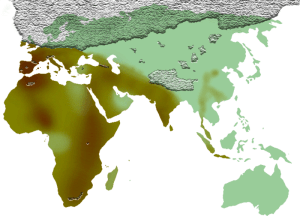
Researchers may have found answers to some questions surrounding stone tool artifacts previously unearthed at the site of Fengshudao, located in the Bose Basin in the Guanxi province of southern China. The site is well known for yielding a lithic assemblage rich in Paleolithic bifacially worked stone artifacts, technically known as Acheulean handaxes, a stone tool most commonly associated with an early hominin (human ancestor) classified as Homo erectus.
After initial discovery and analysis, these ‘Bose Basin handaxes’ came to the attention of the international scientific community because they were dated to about 803 ka (thousands of years), placing them in the Early to Middle Pleistocene period; and because their presence tested the validity of the Movius Line, a theoretical line drawn across northern India, first proposed by the American archaeologist Hallam L. Movius in 1948 to demonstrate a technological difference between the early prehistoric tool technologies of the east and west of the Old World. However, questions were almost immediately raised because the age was based on the supposed association of the artifacts with tektites that may or may not have been redeposited at the site. Moreover, at the time of the initial publications, all of the Bose Basin handaxes were surface collected. Thus, whether the Bose bifaces could validly be associated with the tektites and whether the tektites themselves were redeposited became arguing points for the finding’s critics.
______________________________
Map of the area where the hand axe cultures (Acheulean) extend during the Middle Pleistocene. Wikimedia Commons
________________________________
Now, however, new excavations at the site and subsequent analysis led by Wei Wang of the Guangxi Museum of Nationalities and Christopher Bae of the University of Hawaii are reporting new findings from more recent excavations at the site. Based on ‘in situ’ excavation of tektites, which the excavators maintain do not indicate any evidence of redeposition, along with their association with bifaces within the same stratigraphic level, they are now suggesting with greater confidence that the age of the stone tools should indeed be close to 803 ka. In addition, they report that the Fengshudao hominins were utilizing locally-available quartz, quartzite, and sandstone river cobbles, and that the Fengshudao handaxe morphology differs from the western Acheulean type in a number of ways. They add further that the handaxes are comparatively larger and thicker than those of other regions of eastern Asia (e.g., Luonan Basin, China; Imjin/Hantan River Basins, Korea).
“Although Fengshudao may be a case of western Acheulean hominins dispersing into the Bose Basin from nearby South Asia,” concludes Wang, et. al, “it is quite possible that the Fengshudao bifaces can be considered an example of convergent evolution.”*
________________________________
Source: Edited and adapted from the abstract of Middel Pleistocene bifaces from Fengshudao (Bose Basin, Guangxi, China), by Wei Wang, et. al, Journal of Human Evolution, Volume 69, April 2014, pp. 110 – 122.
*http://dx.doi.org/10.1016/j.jhevol.2013.11.002
________________________________
Read about the most fascinating discoveries with a premium subscription to Popular Archaeology Magazine. Find out what Popular Archaeology Magazine is all about. AND MORE:
 On the go? Purchase the mobile version of the current issue of Popular Archaeology Magazine here for only $2.99.
On the go? Purchase the mobile version of the current issue of Popular Archaeology Magazine here for only $2.99.
And, Popular Archaeology’s annual Discovery edition is a selection of the best stories published in Popular Archaeology Magazine in past issues, with an emphasis on some of the most significant, groundbreaking, or fascinating discoveries in the fields of archaeology and paleoanthropology and related fields. At least some of the articles have been updated or revised specifically for the Discovery edition. We can confidently say that there is no other single issue of an archaeology-related magazine, paper print or online, that contains as much major feature article content as this one. The latest issue, volume 2, has just been released. Go to the Discovery edition page for more information.
Subscription Price: A very affordable $5.75 for those who are not already premium subscribers of Popular Archaeology Magazine (It is FREE for premium subscribers to Popular Archaeology). Premium subscribers should email [email protected] and request the special coupon code. Or, for the e-Book version, it can be purchased for only $3.99 at Amazon.com.





